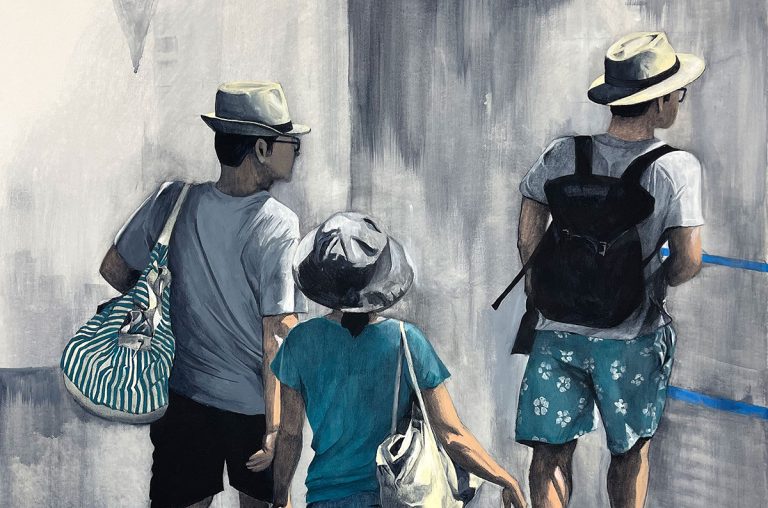Alain Rouschmeyer is an artist who seamlessly bridges the gap between the disciplines of painting, drawing, and architecture. His work primarily focuses on human posture within the familiar spaces of our everyday world. Rouschmeyer’s background as an architect deeply informs his artistic approach, emphasizing the interplay between human form, framing, and canvas format.

Rouschmeyer’s art is a thoughtful exploration of how human posture interacts with its immediate environment. He delves into the correlations between the physical stance of a person and their surroundings, creating compositions that resonate with viewers on an emotional level. His training in architecture shines through as he carefully considers how a person’s posture can influence and be influenced by the space they occupy.
In many of his pieces, Rouschmeyer suggests movement through subtle sketches of postures different from those depicted in the painting. This technique adds a dynamic quality to his work, prompting viewers to reflect on the relationship between the static image and the potential for motion. It invites a deeper engagement, encouraging the audience to question their perceptions and emotional responses to the composition.
One of Rouschmeyer’s recent works, Blue Zone (2024), is an acrylic on canvas that measures 120 x 80 cm. The painting offers a unique lens into a familiar yet transformed environment—the village square during a summer when it was adorned with a new, obliquely rhythmic pattern on the ground. This pattern, designed as part of a local initiative to manage parking time and enhance the visitor experience, serves as the backdrop for Rouschmeyer’s exploration of human behavior and interaction with space.
The Blue Zone is not just a place; it’s a concept that Rouschmeyer brings to life through his thoughtful consideration of how people move through and occupy space. The brightly colored geometric pattern, intended to regulate parking, inadvertently became a stage for an array of human behaviors. Families, couples, and individuals unknowingly adapted their movements to the pattern, creating a spontaneous choreography that Rouschmeyer captures in his work.
In Blue Zone, the artist uses a combination of vibrant colors and sharp lines to depict the geometric pattern that covers the ground. The pattern itself becomes a central element in the composition, influencing the flow of the figures that populate the scene. Rouschmeyer’s use of color is particularly vivid here; the bright blues and contrasting tones are not merely aesthetic choices but serve to underscore the tension between the imposed order of the pattern and the organic, unpredictable nature of human movement.
The people in the painting are shown in various states of motion, some clearly following the lines of the pattern, others seemingly oblivious to it. This juxtaposition highlights Rouschmeyer’s interest in the interaction between structure and spontaneity. The sparrows, often startled into flight by the sudden movement of a passing family, add another layer of dynamism to the scene, reminding the viewer of the constant interplay between the natural and the man-made.
What makes Blue Zone particularly different is Rouschmeyer’s subtle suggestion of potential movement beyond what is immediately visible. The postures of the people, some caught mid-stride, others pausing as if contemplating their next move, are rendered with a fluidity that suggests they could just as easily shift direction or alter their path. This quality invites the viewer to imagine the continuation of the scene beyond the confines of the canvas, creating a sense of ongoing narrative.
Rouschmeyer’s architectural background is evident in his careful attention to the relationship between the people and the space they inhabit. The canvas itself becomes a space to be navigated, with the figures and patterns acting as guides. The artist’s ability to convey a sense of movement within a static medium reflects his understanding of both human behavior and spatial dynamics.
In Blue Zone, Alain Rouschmeyer offers a nuanced exploration of how imposed structures influence human behavior, all while maintaining a keen sense of the underlying potential for spontaneity and change. The painting is a vivid reminder of how our environments, no matter how familiar, can be transformed through both design and the simple act of movement. As viewers, we are invited to reflect on our own interactions with the spaces we navigate daily, and perhaps, like the people in Rouschmeyer’s work, find ourselves moving in unexpected ways.

